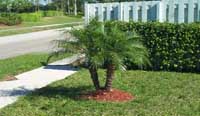| Planting and Fertilizing |
 |
|
| |
Planting a Palm Tree
 Planting palm trees is similar, in most ways, to planting other kinds of trees. Nursery-grown palms are generally sold either potted or balled and burlapped. Try to plant your tree shortly after purchase. If there is going to be any time lag between purchase and planting, make sure that the tree's root ball is kept moist but not soaking. When transporting and handling palm trees, use care. The bark is easily damaged and damaged areas leave the tree vulnerable to insects and fungus. The best time of year to plant is during the warmer months when the soil temperature is at least 65 degrees F. Planting palm trees is similar, in most ways, to planting other kinds of trees. Nursery-grown palms are generally sold either potted or balled and burlapped. Try to plant your tree shortly after purchase. If there is going to be any time lag between purchase and planting, make sure that the tree's root ball is kept moist but not soaking. When transporting and handling palm trees, use care. The bark is easily damaged and damaged areas leave the tree vulnerable to insects and fungus. The best time of year to plant is during the warmer months when the soil temperature is at least 65 degrees F.
Dig a hole wide enough to fit the root ball with plenty of room to spare. Twice as wide might be a good rule of thumb in many cases. The hole should be just deep enough so that the tree is planted at the depth at which it was grown. Do not plant the tree any deeper as this may deprive the roots of nutrients and water. When the tree has been situated in the hole, backfill with the freshly dug soil.
When the palm tree has been planted, build a soil barrier around the circumference of the hole to form a dam that will hold water. Then lay down a layer of organic mulch around the tree. About three inches deep should do.
Frequent watering is crucial for newly-planted palm trees. Daily for about the first two weeks and then tapering off over several months as the tree establishes itself. Use a bubbler or arrange a hose to slow soak the area around the tree. It is important not to allow the soil to dry out as this will severely weaken your new palm.
Palm trees also require periodic fertilizer applications. There are commercial mixes available especially for palms. For more information, Click Here
Finally, exercise caution when using lawnmowers and weed-whippers around palm trees as even minor bark damage may attract insects or invite disease.
|
|
|
| |
|
|
| | |
Copyright ©2010 Palms For Sale |
